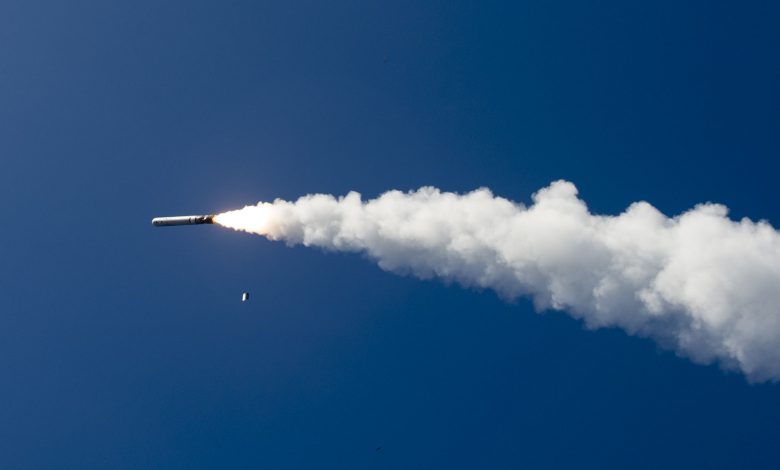Report: Japan Accelerating $1.4B Tomahawk Strike Missile Buy After Pentagon Meeting

Japan plans to acquire Tomahawk cruise missiles a year earlier, announced Japan Defense Minister Minoru Kihara on Wednesday during a press conference in Washington.
The press conference followed his meeting at the Pentagon with U.S. Defense Secretary Lloyd Austin.
Kihara stated that because of the increasingly severe security environment around Japan, he had instructed his staff to move forward with earlier implementation of stand-off defense capabilities. As a result, early acquisition of indigenously produced stand-off missiles was now under consideration, along with bringing forward acquisition of Tomahawk cruise missiles.
He added that the matter had been discussed during his meeting with Austin and that the U.S. has indicated support, though congressional approval would have to be obtained. When asked if the current situation in Congress would affect U.S.-Japan security cooperation and with the plan to acquire Tomahawks earlier, he replied that he and Austing had not discussed the situation in Congress and congressional approval for the early procurement, and it would be a matter for the U.S. Secretary of Defense to comment on.
Japan had earmarked U.S. $1.4 billion for the acquisition of around 400 Block V Tomahawks in FY2026 and FY2027 (Japan’s fiscal year spans from April to March the following year), with 200 missiles to be procured each fiscal year. Under the new plan, some of the Block V Tomahawks would be substituted for Block IV versions, which will be acquired in FY2025 with Block Vs then acquired in FY2026 and FY2027 as previously planned.
Kihara was asked if it was suitable to acquire an earlier model of the Tomahawk and replied that the Block IV’s performance, guidance and range was similar to the Block V and thus was sufficient for Japan’s stand-off requirement. He also said that Japan’s launch platforms for the Tomahawks could launch both versions and operate with a mix of versions. Japan plans to deploy Tomahawks from its Aegis destroyers though ground and submarine launch platforms are also under consideration. Japan currently has eight Aegis destroyers: four Kongō class, two Atago class and two Maya class. It plans to build two new destroyers to be commissioned in
2027 and 2028.
The Japan Defense chief held a 55-minute meeting with the U.S. Defense Secretary at the Pentagon on Wednesday according to a Japan MOD release.
Austin said in his welcoming remarks to Kihara that the U.S. commitment to defend Japan under Article V of the Japan- U.S. Security Treaty, which covers all territories under Japan’s administration, including the Senkaku Islands. The Senkaku Islands are claimed by both China and Taiwan.
The two defense chiefs discussed a variety of topics, primarily centring on U.S.-Japan cooperation and the challenges in regard to Russia’s invasion of Ukraine, China-Russia military cooperation, stability in the Taiwan Straits and the missile and nuclear threat posed by North Korea. Austin and Kihara confirmed advancing trilateral defense cooperation among Japan, the United States and Korea, including efforts toward sharing missile warning data on North Korea in real-time by the end of this year.
Austin and Kihara also concurred on the importance of expanding presence around Japan’s southwest islands. Russian and Chinese naval and air forces have conducted activities in the international waters and airspace surrounding Japan’s southwest islands, which include the Senkaku Islands and Okinawa. China’s activities there also overlap with its activities off Taiwan and its claims on the Senkakus. Japan has been bolstering its military presence in the area.
Meanwhile, U.S. presence in Okinawa is drawing concerns and protests from local residents regarding the Henko land reclamation project, which is intended for the relocation of U.S. Marine Corps Air Station Futenma.
Japan’s government on Thursday through its Ministry of Land, Infrastructure, Transport and Tourism filed a lawsuit to remove the Okinawa state government from future decision-making regarding the Henoko land reclamation project. The move came after Okinawa governor Denny Tamaki – who opposes the project – missed a government-set deadline on Wednesday regarding a design change application for the Henoko project submitted by the Defense Ministry.
Kihara’s visit to the United States marks his first overseas visit since his appointment as Japan’s defense minister on Sept. 13. He also met with National Security Advisor Jake Sullivan prior to his Pentagon meeting, though no details of their discussion were released.





